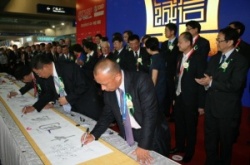At CMEF Chinese companies campaign for quality and sustainability
Quality will be at the root of enhancing competitiveness of Chinese medical technology in developed countries
CMEF, the China International Medical Equipment Fair, is a semi-annual tradeshow which presents innovative products from and for China, and a cornucopia of educational congresses, workshops on financing, seminars on regulatory and policymaking issues as well as networking opportunities.

As a symbol of the highly dynamic healthcare technology market driven also by funding from the national and provincial governments, the 2013 spring show occupies the spacious convention centre in Shenzhen down to the last square metre. It opened on April 17 drawing enormous crowds of professionals from China, Asia, and most other parts of the world.
The official grand opening ceremony centred around a key initiative launched at CMEF. Representatives from more than a dozen member companies of the China Association for Medical Devices Industry (CAMDI) signed a pledge to strengthen the credibility of China’s medtech offering – a campaign which aims at key factors such as quality and sustainability, as suggested the speech of Zhao Yixin, chairman of medtech manufacturer Shinva and Director of CAMDI. Goals achieved, the widely held perception of this industry may well change significantly.
Care and technology in China
China is a country with multiple economies, explained Xie Wenjian at CMEF. Its population of 1.35 bn created a GDP of USD 8,183 bn, with 7.8 percent growth (figures of 2012). According to the Vice President, CAMDI und President, Johnson & Johnson China, key trends in healthcare range from an aging society with a changing lifestyle, a deepening healthcare reform, vertical integration of the provider system, erosion of prices for medical products, and an intensifying competition. Between 2009 and 2012, government expenditure on health care reached USD 353 bn. Priorities of the reform include establishing a basic health insurance system, building a national essential drug list, strengthening primary care, ensuring equal access to public health services, and advancing the reform on public hospitals. Implications, said Xie, are growing affordability of access, improved capabilities of rural medical care, and the emergence of a two-tier, premium vs. mass market system.
Views from Europe, the U.S., and Korea
“Are Belgian, and in general European manufacturers lacking a sense of urgency?” asked Johan D’Halleweyn, Consul General of Belgium, at the ceremony. He expressed his concern about fewer manufacturers from his country being present at CMEF compared to the previous year, while the Chinese demand for medical technology, and potential opportunities for companies from Europe, are experiencing a significant further expansion in volume: “China is the largest, and fastest growing, market worldwide; if you don’t hook your wagon on the Chinese locomotive, you’re lost.” Figures speak for themselves, said the consul; while certain caution may still be necessary in the context of intellectual property rights, that situation is improving on the legal side. The quality initiative inaugurated at the show may help Chinese manufacturers gain recognition in a market which often still looks at their products as not having reached the quality levels of European and American products. Chinese vendors are buying European companies in order to make headway in this regard, the consul mentioned: “This initiative is one step in the right direction.” It will serve to enhance a competitive market also in Europe.
It will take a while for quality aims to be achieved, suggested Armin Siegert. Quality will be of major importance not only in international markets, but for the domestic market too where requirements are becoming more rigid and where international offerings are taking a large share. “But, maybe more importantly, let me remind you that China is a huge market with an incredible potential”, added the Head of the Department for International Economic Affairs, Nuremberg/Germany Chamber of Commerce. The organizer of the Bavarian booth went on to describe the CMEF Spring Show as the second largest event worldwide right after Medica, with an enormous number of, e.g., delegates from Arab and Asian countries – “a perfect platform for the presentation of products. CMEF is undoubtedly designed for even further growth.”
The perception in China, substantiated or not, is often that products imported from Europe and the U.S. come with high quality and a high price, said Paul Benton. Certain domestic products may not have been at the same quality level, the Director of International Activities, Association of British Healthcare Industries (ABHI) continued to explain the situation in the country. To continue to raise those quality standards is necessarily positive for patients. Be it for the domestic or international market – patient safety is paramount. If aims can be achieved, “this is certainly a good thing in the long run.” When Chinese products move further up the value chain, prices follow along, and markets will change; harmonized regulatory processes would be welcomed by many actors, commented Benton.
With the pledged investment into quality, tested quality systems in manufacturing might become part of Chinese approaches to approval which is currently dominated by type testing, re-enforced an unnamed U.S. official. Those systems and audits from, e.g., the U.S. and Europe could then become elements of approval procedures in the country. The official pointed to the harmonization of such standards which, for some years, has been pushed for by a multi-country task force.
China plays a major role as an export market for Korean manufacturers, summarized Byung-Chul Ahn, General Manager of the Planning Department, Korea Medical Devices Industrial Cooperation Association. On the other hand, the product offering from China will be characterized by advanced technology, which – in conjunction with further improved quality – will make it very competitive also in the developed South Korean market.
Aiming at improved patient safety and outcomes
The CAMDI initiative is designed primarily to ensure patient safety, positive outcomes, and effectiveness in hospitals, underlined Dai Jianping, Professor of Radiology in the Beijing Neurosurgical Institute and Beijing Tiantan Hospital, Capital Medical University. More and more CAMDI members will sign the pledge, predicted the opinion leader who also acts as Vice President, China Medical Association (CMA). In general, manufacturers will need to learn to identify the needs of, in particular, smaller hospitals in rural areas which are receiving added attention in the reform. Information and communication technology is gaining momentum in a society which will need to provide access to multi-morbid aging patients. Many vendors, including international stakeholders, are ready to roll out solutions in China’s huge and changing market, suggested Prof. Dai.
18.04.2013









